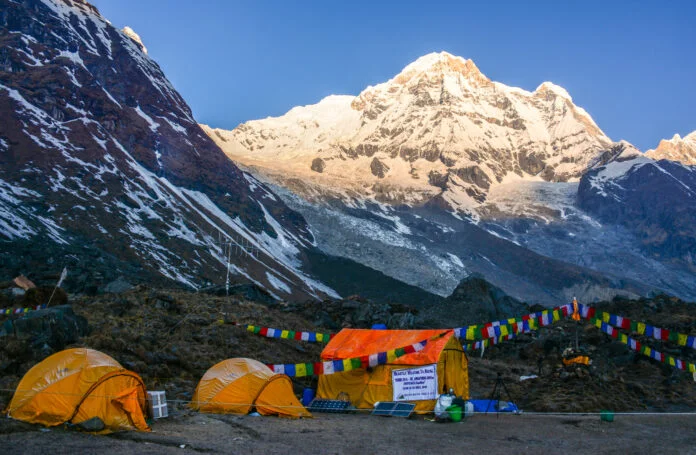Introduction:
Nepal, often referred to as the “Land of the Himalayas,” boasts some of the world’s most breathtaking trekking routes, each offering a unique experience for adventurers and nature enthusiasts. Among these, the Annapurna Base Camp trek stands out as a mesmerizing journey into the heart of the Annapurna Range. With its stunning landscapes, diverse flora and fauna, and rich cultural encounters, this trek has become a favorite for those seeking an immersive experience in the Himalayas.
The Beginning: Kathmandu to Pokhara
The adventure commences in the bustling capital city of Kathmandu, where trekkers from all corners of the globe gather before embarking on their journey. After securing the necessary permits and getting acclimatized to the Nepali culture, trekkers then make their way to Pokhara, the gateway to the Annapurna region. The scenic drive or short domestic flight from Kathmandu to Pokhara sets the stage for the awe-inspiring beauty that lies ahead.
The Trek Begins: Nayapul to Tikhedhunga
The Annapurna Base Camp trek traditionally starts in Nayapul, a small town a couple of hours away from Pokhara. The first day of the trek is a relatively easy walk to Tikhedhunga, which allows trekkers to gradually ease into the rhythm of trekking. The lush green terraced fields, charming teahouses, and the sound of the Modi Khola River provide a warm welcome to the trekking route.
Ascending Through Villages: Tikhedhunga to Chhomrong
As the trek progresses, the terrain becomes more challenging. The ascent from Tikhedhunga to Chhomrong presents trekkers with steep stone staircases that wind through dense forests. Along the way, hikers pass through traditional Gurung and Magar villages, providing a glimpse into the rich cultural tapestry of the region. Chhomrong, perched on the edge of a deep gorge, offers stunning views of the Annapurna South and Machapuchare peaks.
Into the Sanctuary: Chhomrong to Annapurna Base Camp
The most thrilling part of the journey begins as trekkers leave Chhomrong behind and enter the Annapurna Sanctuary. The trail winds through bamboo and rhododendron forests, leading to the lush and green Machapuchare Base Camp (MBC). MBC is an excellent acclimatization spot with its stunning mountain vistas and cozy teahouses.
Continuing from MBC, the trail gradually opens up to reveal the Annapurna Sanctuary. Surrounded by towering peaks, including Annapurna I (8,091 meters) and Annapurna South (7,219 meters), this ethereal location is the ultimate destination of the trek. The moment you arrive at Annapurna Base Camp (ABC), you’ll be captivated by the panoramic views of snow-clad giants glistening in the morning sun.
A Symphony of Nature: Flora and Fauna
The Annapurna region is a haven for biodiversity. As you trek through its diverse landscapes, you’ll encounter a rich variety of flora and fauna. From blooming rhododendron forests in the lower reaches to alpine meadows adorned with vibrant wildflowers at higher elevations, the trek is a sensory feast.
In addition to the flora, the Annapurna region is home to an array of wildlife, including Himalayan Thars, langur monkeys, and various species of pheasants. Birdwatchers will be delighted by the opportunity to spot rare avian species in this pristine environment.
Cultural Encounters: The Gurung and Magar Communities
One of the highlights of the Annapurna Base Camp trek is the chance to immerse yourself in the local culture. The Gurung and Magar communities, renowned for their warmth and hospitality, welcome trekkers with open arms. You can stay in teahouses run by these communities, enjoy traditional Nepali meals, and even participate in cultural dances and rituals.
Weather and Best Time to Trek
The Annapurna Base Camp trek is a year-round adventure, but the best time to visit is during the spring (March to May) and autumn (September to November) seasons. These months offer stable weather conditions, clear skies, and ideal temperatures for trekking. While winter treks can be rewarding for those seeking solitude, they come with colder temperatures and potential snowfall, making the trails more challenging.
Preparing for the Trek
Before embarking on the Annapurna Base Camp trek, it’s essential to be well-prepared. Here are a few tips:
- Fitness: While the trek doesn’t require mountaineering skills, it’s essential to be in good physical shape. Regular cardio and strength training will help you endure the long, sometimes steep, ascents.
- Gear: Invest in good-quality trekking gear, including sturdy hiking boots, warm clothing, and a comfortable backpack. Don’t forget essentials like a trekking pole and a high-quality sleeping bag.
- Permits: Ensure you have the necessary permits, such as the Annapurna Conservation Area Permit (ACAP) and the Trekkers’ Information Management System (TIMS) card.
- Altitude Sickness: Be aware of the symptoms of altitude sickness and acclimatize properly. Follow the “climb high, sleep low” principle to minimize the risk.
Conclusion: A Trek to Remember
Trekking to Annapurna Base Camp is a journey that combines natural beauty, cultural richness, and physical challenge in perfect harmony. It’s a trek that leaves an indelible mark on your heart, inspiring awe and reverence for the Himalayan landscape and its people. As you stand amidst the towering peaks at Annapurna Base Camp, you’ll not only conquer the trail but also discover the profound sense of accomplishment that comes with such an incredible adventure. So, pack your bags, lace up your boots, and get ready to experience the magic of the Annapurna Base Camp trek – a true wonder of the natural world.

